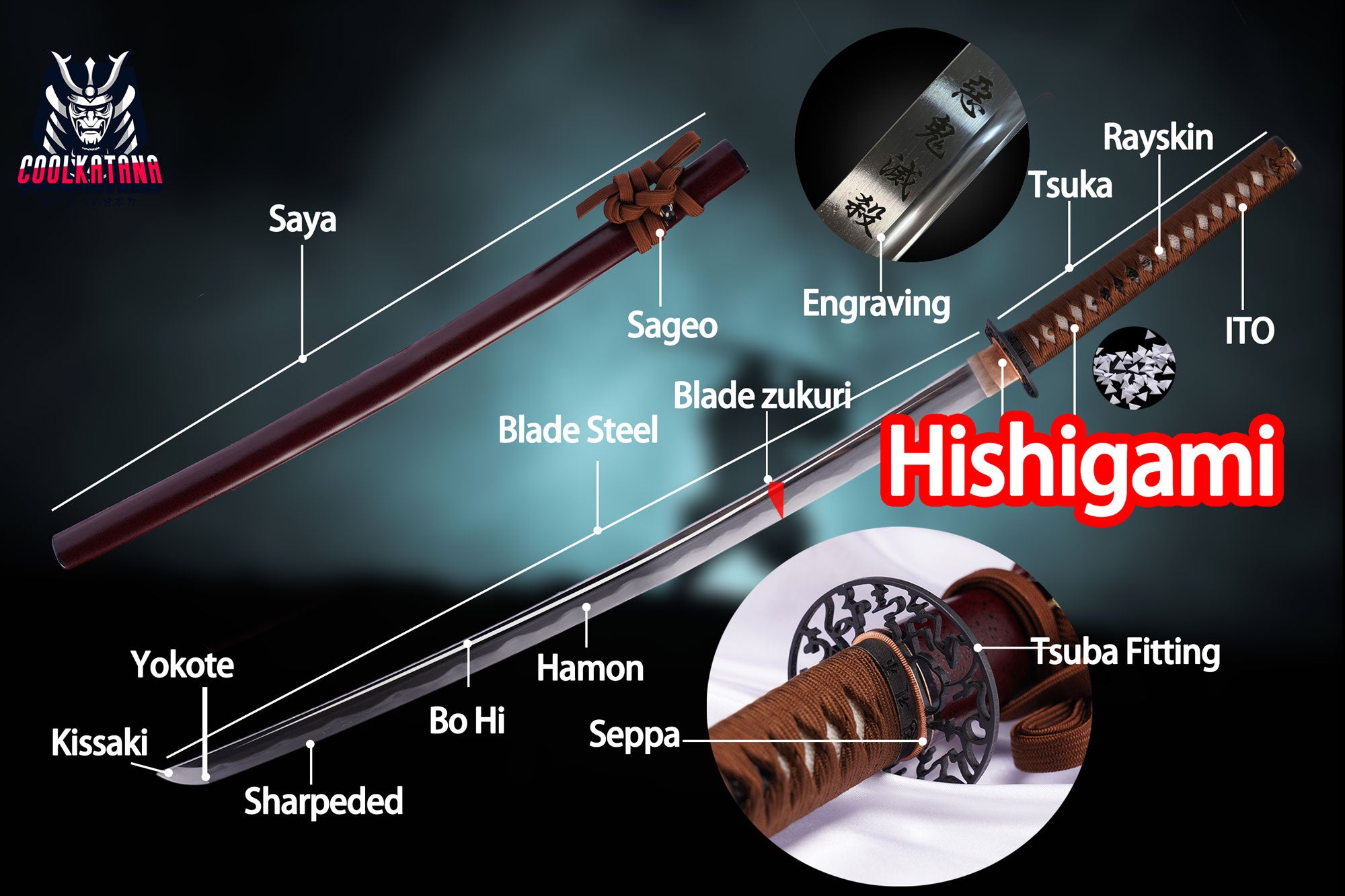Uses, Advantages, and Features of Hishigami in Samurai Sword Making

In the process of traditional Japanese samurai sword making, every detail plays a crucial role in determining the sword's quality and performance. Hishigami is one such important technique often used to improve the sword's stability and durability. In this article, we will explore the uses, advantages, and features of Hishigami to help readers understand its significance in samurai sword crafting.
1. What is Hishigami (菱神)?
Hishigami refers to paper wedges or paper shims used in the production of samurai swords. These wedges are typically made from paper or similar materials and are inserted between the sword's handle (tsuka) and the blade tang ( nakago). The purpose of these paper wedges is to adjust the tightness and stability of the connection between the handle and the blade. By using Hishigami, swordsmiths can ensure that the handle is securely fixed onto the blade, preventing looseness, vibration, or damage.
While Hishigami is often considered a small detail in the traditional sword-making process, it plays a significant role in the sword's overall stability, durability, and user experience.

2. Uses of Hishigami
-
Improving the Tightness of the Handle
During the making of a samurai sword, the connection between the handle and the blade must be extremely tight. By inserting Hishigami (paper wedges), the gap between the handle and the tang can be adjusted to ensure a secure and firm connection, preventing looseness and enhancing the sword's stability during use. -
Enhancing Handle Stability
Over time, factors such as friction, moisture, and temperature changes can cause slight deformation in the handle. This may lead to looseness between the handle and the blade. Hishigami effectively mitigates this issue by maintaining the handle's stability, ensuring that the sword remains robust and secure. -
Protecting the Handle and Blade
Hishigami also serves as a protective layer, preventing direct contact between the handle and the blade, which could cause wear or damage. The paper wedge creates a cushioning effect, reducing friction and the risk of scratches or other damage to the sword's appearance. -
Repair and Maintenance
For older swords, the handle may loosen or show signs of wear due to prolonged use. By adding new Hishigami, swordsmiths can restore the stability of the handle without needing to replace the entire handle. This helps reduce repair costs and extends the life of the sword.
3. Advantages of Hishigami
-
Improved Structural Stability
As a key material for adjusting the connection between the handle and the blade, Hishigami effectively enhances the overall structural stability of the sword. This prevents wobbling or looseness during use, resulting in a better user experience and safer handling. -
High Durability
Traditional Hishigami is usually made from sturdy paper, but it may also be crafted from synthetic materials in modern sword-making. These materials are highly durable and capable of withstanding the pressure and friction from prolonged use, making them less likely to tear or deform. -
Easy to Replace and Maintain
One of the significant advantages of Hishigami is its ease of replacement and maintenance. When the handle becomes loose or worn, the paper wedge can be easily replaced, without the need for a complete handle replacement. This provides a simple and efficient way to maintain the sword's quality over time. -
Protecting the Sword's Appearance
By cushioning the contact between the handle and the blade, Hishigami helps reduce friction, which in turn protects the sword's appearance. This is especially valuable in the maintenance of high-end samurai swords, where preserving the aesthetics of both the blade and handle is a priority.

4. Features of Hishigami
-
Material Variety
Traditional Hishigami is typically made from paper, but with advancements in technology, modern Hishigami may incorporate high-quality synthetic papers or fabrics. These materials offer greater durability, providing more extended protection. -
Highly Customizable
The thickness and material of Hishigami can be customized according to the specific type of sword, handle material, and user preferences. Swordsmiths adjust the size and density of the paper wedge to ensure the best fit between the handle and tang. -
Simple and Effective Crafting
Although Hishigami may seem like a simple detail, it plays a crucial role in ensuring handle stability and extending the lifespan of the sword. It is an indispensable part of the overall protection, stability, and comfort of the sword. -
Versatile Application
Hishigami is not limited to new sword production but is also used in the repair and maintenance of older swords. Whether for modern samurai swords or antique blades, the use of Hishigami significantly enhances the sword's overall quality and performance.
www.coolkatana.com
5. Conclusion
Hishigami is a vital technique in samurai sword making and maintenance. It adjusts the tightness between the handle and blade, enhances structural stability, protects the sword's appearance, and facilitates easier maintenance and repair. Although it may seem like a minor detail, Hishigami plays a crucial role in the overall quality and longevity of a samurai sword.
Whether as part of the initial production of a new sword or during repair and maintenance, Hishigami is indispensable. It not only improves the sword's performance and user experience but also preserves the craftsmanship and tradition of Japanese sword making. If you are a sword enthusiast or someone interested in the finer details of samurai sword craftsmanship, Hishigami is a key element worth understanding and appreciating.

